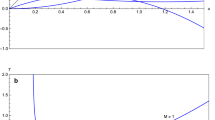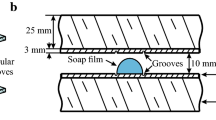Abstract
A shock tube experimental investigation and numerical simulations are undertaken to study the evolution of a perturbed interface of two different gases accelerated by a shock wave. The experimental method is based on a high-speed camera laser sheet diagnostic technique, and simulations are provided by our code CARBUR based on a finite volume discretization of Navier–Stokes’s equations. Two gas pairs are used to illustrate both the heavy/light (air/He) and the light/ heavy (air/SF6) cases. Two simultaneous large initial perturbations, one positive and one negative, are tested for an incident shock wave Mach number in air of about 1.3. The thin membrane (less than 1 μ) which materializes the initial interface between the two test gases presents 2D perturbations whose wave number is close to 1 in order to rapidly reach the non-linear regime. The development of the perturbations is captured at a frequency of 10 kHz after the interface acceleration, and the experiments are complemented with a numerical simulation to validate the interface deformations. Results show an asymmetric mutual gas penetration increasing with the absolute value of the Atwood’s number. Furthermore, they confirm that the heavier gas penetrates the lighter as thin spikes and the lighter gas penetrates the heavier as large bubbles. Moreover, we show that the spike moves faster than the bubble in the heavy/light case and slightly faster in the light/heavy one. Finally, numerical and experimental results are in agreement.
Similar content being viewed by others
References
Richtmyer R. (1960) Taylor instability in shock acceleration of compressible fluids. Comm. Pure Appl. Math XIII, 297–319
Meshkov E. (1970) Instability of a shock wave accelerated interface between two gases. NASA Tech. Transl. 13, 74
Lindl J.D., McCrory R.L., Campbell E.M. (1992) Progress toward ignition and burn propagation in inertial confinement fusion. Phys. Today 45(9): 32–50
Arnett W.D., Bahcall J.N., Kirshner R.P., Woosley S.E. (1989) Supernova 1987A. Annu. Rev. Astron. Astrophys. 27, 629–700
Yang J., Kubota T., Zukoski E.E. (1993) Application of shock-induced-mixing to supersonic combustion. AIAA J. 31, 854–862
Jacobs J.W., Krivets V.V. (2005). Experiments on the late-time development of single-mode Richtmyer–Meshkov instability. Phys. Fluids 17, 034105
Houas L., Jourdan G., Schwaederle L., Carrey R., Diaz F. (2003) A new large cross section shock tube for interface hydrodynamic instability induced turbulent mixing study. Shock Waves 12, 39–57
Picone J., Boris J.P. (1988) Vorticity generation by shock propagation through bubbles in a gas. J. Fluid Mech. 187, 23–51
Hawley J., Zabusky N.J. (1989) Vortex paradigm for shock accelerated density stratified interfaces. Phys. Rev. Lett. 63, 1242–1244
Samtaney R., Zabusky N.J. (1994) Circulation deposition on shock-accelerated planar and curved density stratified interfaces. J. Fluid Mech. 269, 45–78
Jacobs J.W.(1993). The dynamics of shock accelerated light and heavy gas cylinder. Phys. Fluids. 5, 2239
Collins B.D., Jacobs J.W. (2002) PLIF flow visualization and measurements of the Richtmyer–Meshkov instability of an air/SF6 interface. J. Fluid Mech. 464, 113–136
Zoldi, C.A.: A numerical and experimental study of a shock-accelerated heavy gas cylinder. SUNY Stony Brook, (2002)
Jourdan G., Houas L., Billiotte M. (1997) Density evolution within a shock accelerated gaseous interface. Phys. Rev. Lett. 78(3): 452–455
Jourdan G., Houas L., Haas J.F., Ben-Dor G. (1997) Thickness and volume measurements of a Richtmyer-Meshkov instability-induced mixing zone in a square shock tube. J. Fluid Mech. 349, 67–94
Houas L., Chemouni I. (1996) Experimental investigation of Richtmyer–Meshkov instability in shock tube. Phys. Fluids 8, 614–627
Giordano, J., Burtschell, Y., Layes, G., Jourdan, G., Houas, L.: (2004) On the mutual penetrations of two gases submitted to the Richtmyer–Meshkov instability: part 2, numerical simulation. In: Proceeding of the 9th IWPCTM
Burtschell Y., Cardoso M., Zeitoun D.E. (2001) Numerical analysis of reducing driver gas contamination in impulse shock tunnels. AIAA J. 39(12): 2357–2365
Hoffmann, K.A., Chiang, S.T., Siddiqui, S., Papadakis, M.: Fundamental equations of fluid mechanics. Engineering Education System (1996)
Toro E.F. (1997) Riemann Solvers and Numerical Methods for Fluid Dynamics. Springer, Berlin Heidelberg New York
Author information
Authors and Affiliations
Corresponding author
Additional information
Communicated by D. Zeitoun.
Rights and permissions
About this article
Cite this article
Giordano, J., Jourdan, G., Burtschell, Y. et al. On the Mutual Penetrations of Two Fluids Whose Interface is Accelerated by a Shock Wave. Shock Waves 15, 375–382 (2006). https://doi.org/10.1007/s00193-006-0029-y
Received:
Accepted:
Published:
Issue Date:
DOI: https://doi.org/10.1007/s00193-006-0029-y




